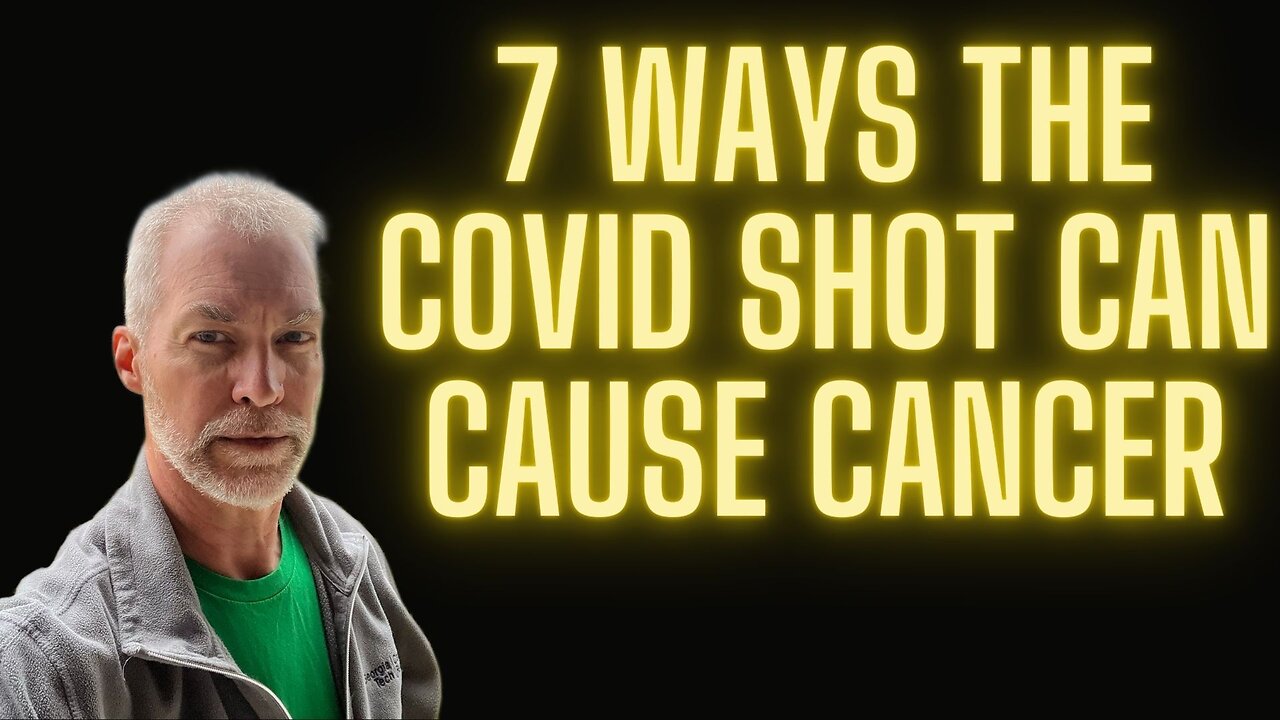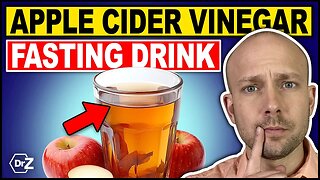Premium Only Content

125. Chris Clagett, How the COVID Shot Can Cause Cancer
Today I talk with Dr. Chris Clagett, MD, MPH. Dr. Clagett is a retired Navy Preventive Medicine Physician. He talks about the Declaration of Military Accountability (DMA) and he talks about the disastrous COVID-19 shots that can cause cancer in at least 7 different ways.
If you like my t-shirt please get one here:
If you would like to purchase better than grass fed and grass finished beef that will never get mRNA injections, never get growth hormones and never get antibiotics check out mycleanbeef.com/afterhours
As always please like, share and follow. Please check out my Patreon account (https://www.patreon.com/Afterhourswithdrsigoloff). This is mostly to help with the legal fees. Please consider contributing but if you are unable to donate money please give prayers.
truthforhealth.org for COVID illness and long haulers syndrome treatment protocols. If you have a vaccine injury (from any vaccine or have any injury that you think may have any relation to any vaccine) please report in their civilian equivalent to VAERS.
Patreon: https://www.patreon.com/Afterhourswithdrsigoloff
Email: afterhours@1791.com
Telegram: https://t.me/afterhourswithdrsigoloff
Instagram: @afterhourswithdrsigoloff
Clouthub: @DrSigoloff
TruthSocial: @DrSigoloff
Rumble: https://rumble.com/c/AfterHoursWithDrSigoloff
Youtube: https://www.youtube.com/channel/UCQ_ng3WYVhnctCYq6Rom07g
Givesendgo: https://www.givesendgo.com/G37EN
125. Chris Clagett, How can it cause cancer
===
Dr. Chris Clagett: [00:00:00] You talked about, you know, mechanisms by which the injectable genes cause cancer. I think I can tick off seven. The one mechanism by which they outright cause cancer is by reverse integration into the chromosomes, the, the nuclear genome. The problem is one, you cannot control the location of the integration.
Dr. Chris Clagett: And this is why gene therapy has always, always, always failed. They can't control the site of integration. Gene therapy is associated with cancer.
Dr. Sam Sigoloff: Doesn't dinner sound great as it's cooking? This dinner is from Riverbend Ranch, which always provides prime or high choice, has never been given hormones, never been given antibiotics, never been given mRNA vaccines.
Dr. Sam Sigoloff: It's raised in the U. S. A. It's processed in the U. S. A. In fact, it's fully vertically integrated, which means that they own the cow, it gives birth to the calf, it's raised on their fields, and then taken to their [00:01:00] butcher, and then shipped to you. And if we compare, What we can buy from River Bend Ranch to four other major state companies that sell bundles that have ribeyes and other meat in it.
Dr. Sam Sigoloff: It can be as much as 184 to 59 less expensive. It's a great price value and it's a delicious piece of meat. Check out MyCleanBeef.com/Afterhours. That's mycleanbeef.com/afterhours, mycleanbeef.com/afterhours.
Nurse Kelly: Welcome to After Hours with Dr. Sigoloff.
Nurse Kelly: On this podcast, you will be encouraged to question
Nurse Kelly: everything.[00:02:00]
Nurse Kelly: And to have the courage to stand for the
Nurse Kelly: truth. And now, to your host, Dr. Sigoloff.
Dr. Sam Sigoloff: I want to for joining me again. I first want to give a shout out to all my Patreon supporters. We've got Too Tough giving 30. 00. A month, we've got the anonymous family donor giving 20. 20 a month. And then we have the plandemic reprimando giving 17. 76 a month with Ty, Charles, Tinfoil, Stanley, Dr. Anna, Frank. Brian, Shell, Brantley, Gary, and Sharon. We've got Kevin giving 10 and Pat and Bev giving 10 a month. We have the Refine Not Burn level at 5 with Linda, Emmy, Joe, PJ, Rebecca, and Matt. Marcus, Elizabeth, Don, Ken, Rick, Mary, and Amanda. We have Addison Mulder giving 3 a month, and Frank giving 1. 50. And then finally, Courage is Contagious level at 1 a month with Jay, SpessNasty, Durell, Susan, and BB King and Caleb.
Dr. Sam Sigoloff: I want to [00:03:00] thank you all so much for helping me get these episodes out to you. You'll get an extra special sneak peek of these before they actually get aired. Also, check out MyCleanBeef. com slash After Hours. That's MyCleanBeef. com slash After Hours for some of the best beef that I've ever had. My next guest, I have Dr.
Dr. Sam Sigoloff: Chris Kleggett on, and he is a, um, Preventative health physician. So what he does is he specializes in learning what diseases are out there and how to help prevent from them spreading and he knows all about those types of things. Chris, it's so glad to have, I'm so glad to have you on.
Dr. Chris Clagett: Sam, thank you. Thank you for the privilege to speak to your audience.
Dr. Sam Sigoloff: So let's get into what you wanted to talk to talk about today.
Dr. Chris Clagett: What I wanted to talk to your audience about is the Declaration of Military Accountability, which they may be familiar with, at least some of them. And the reason I think that [00:04:00] this is so important, that we hold government accountable. Uh, officials, whether military or civilian, accountable for their lawless actions is because of the harms that they, their, their actions have caused.
Dr. Chris Clagett: You know, if you're, if you're in, you know, say some civilian, civil action, you've had a, you've had a motor vehicle accident. and you're being sued. Uh, the, the, the plaintiff is, is asking for damages that are based on, um, the harms caused to the plaintiff. You know, is there a little bit of fender bender, somebody physically injured, injured, or was somebody in which, you know, and the, the penalties go up commensurately.
Dr. Chris Clagett: Well, with the injectable genes, we have had not only military members, but you know, civilians across the United States, not only have incur life altering vaccine injury, [00:05:00] shouldn't really call it a vaccine. It's, it's an injectable gene, call it a vaccine because that's the common parlance, uh, in the national conversation.
Dr. Chris Clagett: Uh, but they, they don't resemble any historical vaccine. They are, they're a gene, a full gene. 3, 600 nucleotides that code for a 1, 200 plus amino acid protein. No, no vaccine in, in the history of vaccinology has ever attempted to do this. These, these genes that are injected, uh, have not only caused life altering injury, but they've killed many people.
Dr. Chris Clagett: This, this, these, these effects, these, these injuries and deaths, they, they span, uh, American society. Uh, they're not limited to the military. In fact, we probably have fewer, uh, injuries, but the reason the DMA is important is because we need a win. The American [00:06:00] legal system, uh, leans very heavily on the twin principles of precedent and analogy.
Dr. Chris Clagett: And if we can find someone guilty in a court of law for harms caused by either forcing someone to. uh, receive the in the gene injections, uh, and be harmed or killed by them. Then, then there is almost no, uh, place we cannot go in the legal system. Uh, the, I think of the DMA as the, the mall that will split the law.
Dr. Chris Clagett: And, and the reason I think we should start here with, uh, admirals and generals have ordered subordinates to, uh, receive these experimental biologicals on pain of punishment under the UCMJ [00:07:00] or, uh, dismissal from military service with an other than honorable and even dishonorable punishment. uh, characterization of service, which will have lifelong, uh, impact on a person's employability.
Dr. Chris Clagett: So there were many members who, under threat of these, these, uh, adverse actions against them, did take the, uh, indectable genes. They were harmed thereby or killed. And so I guess what I, what I wanted to do is first, uh, go through with you how we know that these, these injuries have occurred. And I'm in preventive medicine and one of the large areas of our, our discipline is, is epidemiology.
Dr. Chris Clagett: The nice thing about epidemiology is that it sometimes allow us, allows us [00:08:00] to understand that a phenomenon is there. and is happening without being fully, uh, cognizant, having fully identified the mechanism of the phenomenon. So, the, the epidemiology, uh, makes, uh, the case for these harms. I'll give you, I'll give you, uh, an example, a historical example, personal, uh, that I was involved in, how the epidemiology makes the case.
Dr. Chris Clagett: Uh, May 2010, we had a small detachment of CBs, 20 people, In the Camorra Islands, that's a small archipelago, uh, between Madagascar and, uh, the African continent. They were there to build a school for the locals. win hearts and minds, that kind of thing. Uh, so May 2010. Now, important history backing up from that was that in [00:09:00] December 2009, right before Christmas, we had a CB from the same task force, uh, who was medevaced to, I think it was, uh, Ramstein, Germany, or Landstuhl actually is the major medical center there.
Dr. Chris Clagett: with malaria. Uh, he had been, uh, I can't remember where he was deployed to, where he acquired his malaria. He, uh, went to sick call with the usual, uh, prodrome for malaria, very vague headache, a little fever, maybe. Maybe, maybe not even a fever, but headache didn't feel good. They gave him, uh, Motrin for headache and then sent him back to his barracks S.
Dr. Chris Clagett: I. Q. for a day. Come back and see us tomorrow if you're not better. He was found the next day unresponsive in his room. He was medevaced to where he died one week later of cerebral malaria with, uh, Basically, [00:10:00] no circulation above, above this point of his head and his anti malarial medications were in his pocket.
Dr. Chris Clagett: He wasn't taking his pills. So fast forward to May, 2010, the, uh, CBs from the same task force are deploying again, they go to Comoros Islands, it's known that there's malaria there and the independent duty corpsman. has been taught knows that he's the fall guy if anybody gets malaria. So he's got a color coded spreadsheet by name and date and color coded by, you know, which antimalarial they were taking.
Dr. Chris Clagett: We used a combination of mefloquine and hydroxycycline and he was recording, he was literally watching people swallow their pills. Nevertheless, uh, after they'd been there a few months, uh, a couple of them got sick. Now, uh, falciparum malaria can give you almost any [00:11:00] symptom constellation, depending on where in the body those parasites go.
Dr. Chris Clagett: They went to the Host Nation Lab. The Host Nation Lab did a, uh, uh, they took a finger stick, got a thick and thin smear, looked at it, and they said, we see malaria parasites in the blood. They, then they got a bunch of people tested. And, uh, the Host Nation Lab said that they saw four or five more people.
Dr. Chris Clagett: that had parasites in the blood and even quantified the parasitemia. So they were all medevacked back to Djibouti where they came out of. And, uh, I was, uh, sent, uh, to go do the on scene investigation. By the time they got, by the time I met them, they were all clinically resolved. Um, one of our, one of our preventive medicine units swooped in, grabbed some blood, took it back to the research lab in Cairo and, uh, where they, when they ran.
Dr. Chris Clagett: Uh, blood [00:12:00] looking for, uh, antigens. They found 13 of the 20. Uh, no, 8, 8 of the 20 had detectable plasmodium antigens and 13 of the 20 had detectable plasmodial DNA. So they were running PCR and, and people up and down Europe and the East coast of the U. S. were all hyperventilated that, you know, we got more malaria again.
Dr. Chris Clagett: So I, this is where the epidemiology comes in. Again, these guys are all healthy by the time I meet them. This is a record review. So I, I, I find that these guys have been trickling into country over a period of, uh, took a couple of months. And interestingly, their symptoms all began within 40, a 48 hour window, two days, a two day span Monday through Wednesday.
Dr. Chris Clagett: And And then I looked at, you know, what symptoms did [00:13:00] people have? Interestingly, none of them had a fever. That's the number one symptom for malaria. Number one. Uh, it's almost, it's almost a sine qua non, uh, which is Latin for without which not. And none of them had a fever. They'd all been there. for months.
Dr. Chris Clagett: They're a bunch of more smokers. They would go out at night getting, getting their last cigarette before bedtime. So they had asynchronous, asynchronous exposure. Now in the United States, we've had cases of, um, synchronized onset of malaria, but these were all like Boy Scout jamborees and symptom onset was synchronized.
Dr. Chris Clagett: But then you go back in time and you find out that exposure was synchronized. You were all out in the woods, Southeastern United States, Southeastern US used to be a malarious area. And they would, and, and so they, they all had symptom onset, uh, within a very narrow window. [00:14:00] And so we had, we had just kind of a similar symptom onset with these CBs, except that exposure was not, was not synchronous.
Dr. Chris Clagett: So basically, bottom line, jumping down to it, there's basically epidemiology and the fact that none of them have fever. showed me that what they had with a gastrointestinal constellation of symptoms was they, they went out to eat in town and they got food poisoning. It was the malaria, then it was the, the epidemiology that made it.
Dr. Chris Clagett: So with the, with the epidemiology now looking at COVID and we look at all cause mortality, Because a lot of national data sets are corrupted by misattribution of, of cause of death. You can misattribute or genuinely err in the, uh, presumed cause of death, but there's no mistaking the corpse. You've got to, you have a dead person.[00:15:00]
Dr. Chris Clagett: So the, uh, national data sets being corrupted, the thing to look at is all cause of death or all cause mortality. We're going to look at, we're going to look at a couple of countries. We're going to look at, uh, New Zealand and the United Kingdom. I'm going to show you how all cause mortality kind of leads us to, um, well, it leads us to conclusions.
Dr. Chris Clagett: We'll discuss the data as we look at them. So I'm going to, with your permission, uh, Sam, I'm going to go ahead and share my, my first slot, uh, screen.
Dr. Chris Clagett: Okay, and we're going to share the window and share.
Dr. Chris Clagett: Okay, this is all caused mortality over a decade in New Zealand. [00:16:00] Now, if you remember, New Zealand was practically a hermit kingdom. They had severe lockdowns, uh, and they had universal vaccination. Now, here is, of course, the pandemic year. 2020. If we look left, we see that all cause mortality is slowly rising, basically in, in, uh, alignment with, uh, slowly increasing national population.
Dr. Chris Clagett: Interestingly, the pandemic year was, uh, lower than, uh, many of the, uh, the pre pandemic years. The first, the, the preceding three pandemic years. Okay. With the, uh, the, uh, SARS CoV 2 being touted as the, uh, the new Black Death, 2020 should have been much worse. But then, okay, so what [00:17:00] happened to 2021? The, the vaccines rolled out in January of that year, okay?
Dr. Chris Clagett: So, 2021 is about a 15, this is about a 15 percent increase, uh, No, that's not quite right. It's not 15%. I would have to redo the math. Uh, from 2020, and then you will see from 2020 to 2022, all cause mortality accelerates. So we should be, we should be seeing a reduction. If these injections, the gene injections are protective, we should be seeing a reduction in all cause mortality, or at least a return to, uh, the baseline trend, but that's not what happened.
Dr. Chris Clagett: We are, we are in an acceleration period. And then if we zoom in, I'm going to stop sharing this and share a different slide.[00:18:00]
Dr. Chris Clagett: We're going to look at how the, uh, how the New Zealand all cause mortality breaks down by vaccination status. These are, this is, uh, this is New Zealand government data that I'm showing you. Okay. Now, let's see. So, um, Yes, so the unvaccinated. Now, at first blush, this looks actually horrible for the vaccines, which we have to remember that the, the, the, the population is almost universally vaccinated.
Dr. Chris Clagett: Uh, very few New Zealanders successfully held out. So the important thing to look at is where, um, the, the proportion of these people, these individual groups, the fully vaccinated, [00:19:00] the boosted and the unvaccinated in comparison to their proportion in the population. Unfortunately, the New Zealand data do not give that to us in, in this chart, but I'm going to tell you that this chart mirrors what I'm going to show next, which we're going to jump over to the UK.
Dr. Chris Clagett: Okay. And so I'm going to stop sharing this one. And then switch over to the UK. Well, the reason for showing you multiple countries is because this is not a phenomenon isolated to one country share.
Dr. Chris Clagett: Okay. Um, I was going to start with one, but we'll start with two. This is in the UK. This is people who got. Two shots or more. And now you see here in [00:20:00] January, 2021, this is of course where the vaccines rolled out and then the proportion of the population and the proportion of the populations on the left.
Dr. Chris Clagett: Okay. The proportion of the population that have two shots now. So this is the proportion of the population has two or more vaccine shots. And this down here, this is the percentage of the population that are unvaccinated completely. The bottom curve is the proportion of the population that's unvaccinated as a portion of all cause mortality.
Dr. Chris Clagett: So we don't see, we don't see numbers of all cause mortality here. These are proportions. And the top line, this is the percentage of people 18 and over who got two shots as a percentage of all cause mortality. [00:21:00] Now the thing here is that to look at the difference in proportions, okay, 18 and overs that got two shots are 78.
Dr. Chris Clagett: 7 percent of the population, uh, at the far right, but they are 96 percent of the population. of all cause mortality. In other words, they are overrepresented among all cause mortality. These data are truly beautiful. This is, and I'll tell you, these are official government data, but the, the office of national statistics in the UK did not prepare this slide.
Dr. Chris Clagett: Raw numbers were taken off the UK website and used to prepare this slide. At the other end, the unvaccinated are 18 and a half percent. of population, but only 3. 3 percent of all cause mortality. They are underrepresented among all cause mortality. Now I'm gonna, that's gotta, let's see what [00:22:00] we got in.
Dr. Chris Clagett: There's a number to remember. These two curves are gonna be the same in the next slide. We're gonna look at people that got three shots. Let's see, and 96 percent minus, uh, 78. 9%, that's, uh, uh, 96 to 79 would be, uh, 27. Oh, bleh, old brain, getting tired. Um, 96 would be, that's 20%. Subtract another 1. 7%. So they are 18.
Dr. Chris Clagett: 3%. They're overrepresented by 18. 3%, right? Can I ask you a question? And now we're going to look at three. Yeah, go ahead.
Dr. Sam Sigoloff: Where are you going? So this 18 and up, they are, they're making up, they're overrepresented by 96 percent of the overall, uh, all cause mortality. If we looked at, and I don't know if you've, you've done this, but if we looked at the years before, what was that age group before?
Dr. Sam Sigoloff: Was that, [00:23:00] cause that age group, I wonder if there was a higher death rate in that age group. Is it just 18 and up till now? Until infinity, or is it 18 to 65, or is it 18 to 50 something?
Dr. Chris Clagett: 18 and up, 18 to infinity.
Dr. Sam Sigoloff: Okay. Because I wonder if there was a larger rate of death in a certain age group, and I don't know if you're going to get into that later.
Dr. Sam Sigoloff: But that would be very interesting to see.
Dr. Chris Clagett: Um, let's see. Um, Uh, those be, I think the German data, um, would be better for that, um, I would kneel on a haystack among my files. I did not prepare to, uh, share those charts. Um, but so I, I did the map. It's um, so they are overrepresented. 18 and over are overrepresented by 17.
Dr. Chris Clagett: 3 percent. So stop sharing this one. Toggle over. Share new file. [00:24:00] Yes. Okay. So we have the unvaccinated. Same down below. And now we have The proportion of people that got three shots, only 65 percent of the UK 18 and overs got three shots, but they are 91 and a half percent of all cause mortality. Now that superficially looks like, well, they're doing better because the people that got two shots were 90.
Dr. Chris Clagett: 6%, but that's not the calculation that we make. We make, let's see, 91 point 0.5, eh dang it. Clear menu, 1.5 minus 65, 91 point.
Dr. Chris Clagett: There's the difference here is 26.5%. And so the delta here [00:25:00] is larger than it was with people who only got two shots. And the delta for people that got two shots was larger than the delta of people who only got one shot. So what this, this beautifully illustrates to us is that there is a dose response curve between all cause mortality and vaccination shot by shot.
Dr. Chris Clagett: Only the UK data actually, uh, illustrate this, uh, this, this beautifully. Um, and because they, uh, ONS in the UK made it possible to, to compare VAX status, uh, to mortality. They kept records on who's vaccinated and how many. Here in the U. S., we stopped, we stopped keeping records on, um, who's getting shots, uh, because the CDC does not want those data.[00:26:00]
Dr. Chris Clagett: But I'm going to stop sharing this screen. What these, um,
Dr. Chris Clagett: you know, this is a humorous story. I actually had a physician out in Utah, state of Utah, and he's, he's well known on the internet. Uh, argue with me that, uh, state of Utah data show a reduction in all cause mortality among the vaccinated compared to the unvaccinated. Now, if you want to, if you wanted to make the case that the, the gene injections caused a reduction in cause specific mortality, COVID 19 mortality, that's certainly believable.
Dr. Chris Clagett: Uh, we expect that measles, mumps, rubella is going to reduce mortality to measles, mumps, and rubella.
Dr. Chris Clagett: How would, how would getting, uh, an injection with a, a gene that is [00:27:00] intended to immunize us against COVID 19, SARS CoV 2, how is that supposed to protect me from cancer, uh, pneumonia? uh, heart attack, motor vehicle accident, drowning, all cause mortality. He actually claimed that all cause mortality was lower in the vaccinated than the unvaccinated.
Dr. Chris Clagett: It makes no sense. It's, it's completely medically implausible. So what we can say is that the, uh, data in the state of Utah are somehow corrupted. We don't know how, but they're corrupted. But, uh, the UK and New Zealand data conclusively show us that, uh, that all cause mortality has climbed. When it should have declined and, uh, in New Zealand, because they, that chart extended back past the, uh, pandemic year.
Dr. Chris Clagett: We could see that the pandemic [00:28:00] year was actually a low mortality year. And, and that, that pattern holds. That pattern holds across Europe as well. Uh, not sure that the U. S. data, uh, I can't remember if I've seen them, frankly. I've cut so much, but, uh, so we can say that the, uh, the mortality is, uh, uh, there's a, uh, there's a statistician in the U S that says that, uh, cancer mortality, you asked about cancer early on, uh, in, in this interview, cancer mortality is up among the young by 20 Sigma.
Dr. Chris Clagett: 20 standard deviations. It's, it's beyond astronomical.
Dr. Sam Sigoloff: Can you explain standard deviation for a second and how the typical chart, what that looks like, so that people can have a comprehension of what that means?
Dr. Chris Clagett: Roger. Most people are familiar with, you know, the, [00:29:00] the, the bell curve. Okay, so when, so we, we divide bell curves, or just statistical distributions into, um, standard deviations.
Dr. Chris Clagett: A standard deviation is a degree of variance. And we usually do it from the mean, the middle. The, in a standard curve, uh, two standard deviations on either side of the mean will encompass ninety five percent of the entire curve, leaving two and a half percent at each tail. Three standard deviations, uh, encompasses ninety nine, and I think maybe percent, uh, more than ninety nine percent.
Dr. Chris Clagett: So there's 1 percent divided between each of the two tails. When we talk about four standard deviations, now we are [00:30:00] out in, uh, one part per 10, 000 in, of the, of the entire distribution. That's four standard deviations. The statistician was claiming 20 standard deviations. This is, and interestingly, he said, and the CDC is hiding it.
Dr. Chris Clagett: Why, how is the CDC hiding this? By lumping increasing cancers among the young who have, and the reason there's room for them to have a 20 standard deviation, uh, increase in cancer is because cancer in the young young adults is so low to begin with. So it's a 20 standard deviation increase still makes relatively few people on an absolute count terms.
Dr. Chris Clagett: getting cancer. Uh, across the human population, cancer, uh, [00:31:00] cancer, uh, varies. It's bimodal. There's a peak in early childhood, and then it declines, and then, and then it's low throughout young adult, and then slowly starts to go up in increasing old age. So, uh, The young are having an enormous increase in cancer, but it's hidden because the mortality among the, the elderly who are disproportionately affected in the pandemic year, their, their cancer mortality right now is low.
Dr. Chris Clagett: Because that those age bands of the population were kind of depleted relatively, they were relatively depleted. So CDC will say, yeah, we have a little bit of an increase in, uh, in cancer. You don't see it because they're lumping a group that is having, uh, [00:32:00] uh, an abnormal reduction in cancer because of mortality from COVID.
Dr. Chris Clagett: In with a, in with a group that had a very low, uh, COVID mortality, but is having now increasing, uh, cancer due to the gene injections.
Dr. Sam Sigoloff: So what you're saying is the elderly population, we're not seeing the deaths there from cancer because they all died during COVID. And now we're starting to see an equalization of deaths from cancer, but it's coming from a different group.
Dr. Sam Sigoloff: It's coming from the younger population that shouldn't be getting this great rate of cancer.
Dr. Chris Clagett: Exactly. Great. Exactly. They're hiding it. And, uh, so we, you talked about, you know, mechanisms by which the injectable genes cause cancer. I don't have the list in front of me. There's, I think I can tick off seven.
Dr. Chris Clagett: Um, the one mechanism by which they, they outright cause cancer is by reverse [00:33:00] integration into the, the chromosomes, the, the nuclear genome, our, our, our chromosome, uh, our, our, our nuclear genome. is a, is a fantastically complicated thing. We're barely scratching the surface of it. Uh, a, a, a gene, let's say it codes for, uh, uh, the synthesis of a protein, say the protein's a thousand amino acids long.
Dr. Chris Clagett: So the gene is 3, 000 nucleotides long. Uh, that 3, 000 nucleotide What's the term? Intron, I think, could be surrounded by 50, 000 nucleotides of regulatory nucleotides, regulatory sequence, and the, and genes regulate adjacent [00:34:00] genes. It's amazingly complex. And so if you insert a gene that for, that codes for a foreign protein somewhere into the genome, the problem is one, you cannot control the location of the, of the integration.
Dr. Chris Clagett: And this is why gene therapy has always, always, always failed. They can't control the site of integration. Gene therapy is associated with cancer. You're nodding your head. I think you're familiar with this. It's associated with cancer. So if you, if you happen to hit, uh, one of the, one of the actual genes, and it's in this, so this, this foreign gene is, is encoded into it.
Dr. Chris Clagett: It's spliced in. One, you destroy that one functional gene. [00:35:00] And two, you're going to disrupt the, the regulation of nearby genes. Gene expression is so tightly controlled, even among our normal genes, that the overexpression of a gene or an underexpression of a gene are both associated with cancer. It's an amazingly fine tuned apparatus, and so cannot control the gene.
Dr. Chris Clagett: Uh, the point of insertion, almost guaranteed cancer.
Dr. Chris Clagett: Then there are half a dozen mechanisms by which the gene injections will promote cancer. They don't directly cause it, but they could promote it. And this could be a cancer that the gene injection did not directly. Cause let's say you, you had a malignant transformation of some random cell. This happens to us all the time.
Dr. Chris Clagett: Our t lymphocyte line is especially involved in tumor [00:36:00] surveillance and suppression. They, they, they go out, they surveil for and destroy malignantly transformed cells and other abnormal cells, virally infected cells, physiologically stressed cells. Uh, they, they get destroyed. by our, by our, uh, lymphocytic line, CD8, uh, uh, positive T lymphocytes and natural killer cells.
Dr. Chris Clagett: So, uh, what they, what, uh, mechanism one, P53. The spike protein has the nuclear localization sequence. That's a 7 amino acid sequence that basically is like a passkey into the nucleus of the cell. It basically says, open says me. Now a 7 amino acid peptide, that's an amazingly specific, uh, [00:37:00] sequence, uh, with a universe of 20 amino acids to choose from.
Dr. Chris Clagett: The odds of randomly producing Any given seven amino acid peptide is one in 1.28 billion. So this, this nuclear pass key is very specific and the, the spike has it, the, the engineers put it in. So the spike protein is capable of translocating into the nucleus where it binds with this protein called P 53, which is our cells, our nucleuses main DNA repair protein.
Dr. Chris Clagett: DNA repair is an amazingly, amazing process in a three, uh, giga base pair, uh, genome. How does the nucleus know where DNA damage has occurred? [00:38:00] Well, and this, this is like, uh, new data as of, uh, 2017. new developments. The DNA strand is like a, a hyperconductor. So a, a charge donating molecule binds to one end of it, and at the speed of light, uh, this charge propagates along the strand and is removed at the other end.
Dr. Chris Clagett: If, uh, x rays, chemical stress has produced a break, in the, the DNA strands somewhere. Charge is going to be, is begin accumulating. That's how the nucleus repair mechanism knows where to go in a three giga, three billion base pair genome. It goes there and it repairs the protein, the DNA. The spike [00:39:00] binds to p53, this, the nucleus's main DNA repair protein, and it suppresses p53 by 90%.
Dr. Chris Clagett: So spontaneously occurring, um, malignant transformation from, from DNA damage. You know, we're subjected to 300 millirem of natural background radiation every year. You know, you go to the dentist, you get a few more millirem. You get a chest ray, you get a few more millirem. You've got natural radioisotopes inside your body.
Dr. Chris Clagett: Potassium 40, it's ubiquitous. You can't get away from it. We're subjected to radiation. So, we have, we have a designed mechanism to fix that. P53 disables it by 90%. There, uh, the spike disables P53 by 90%. How else? Let's see. The, the, the gene injections disable, [00:40:00] well, they promote, uh, IgG4, uh, transformation.
Dr. Chris Clagett: You're familiar with this, Sam.
Dr. Chris Clagett: I'll, I'll start from the beginning for the audience. We have multiple classes of, uh, immunoglobulin antibody. We call 'em IG for short. IG class, class A, class E, class G, class M, IgG, ig. Class G is one of our main antibodies. It's your memory antibody. It's uh, the, one of their main antibodies that we use to survey.
Dr. Chris Clagett: Uh, against, uh, re infection with, uh, past experienced viruses. So when, when you've gotten, uh, immunizations in the past, the whole point is to build up an IgG response. IgG is conveniently subdivided into four subclasses, conveniently named one through four. IgG 1, 2, and [00:41:00] 3, uh, destroy things. Uh, 1, uh, goes after mainly tumors.
Dr. Chris Clagett: Um, uh, IgG 2 goes after, uh, environmental things like bee venom, other stuff. Stuff you need to clean up, but not urgently. IgG 3 is your main antivirus, uh, antibody. And it also does, I think, a little work on, on, uh, malignant cells. IgG4 is special. IgG4 is your immunotolerance antibody. It's what you, it's what you direct against environmental irritants like pollens, pet danders, peanut protein.
Dr. Chris Clagett: You've, you've probably all seen the news in recent years. Uh, where, uh, kids have peanut allergies. Mom never gave them PBJs as a kid. She should have. Give your kids [00:42:00] PBJs. So, uh, it, IgG4 prevents us from mounting an inflammatory reaction against things that don't need an inflammatory reaction. But IgG4 is, IgG4, we, we, we mount this when we see something frequently and in large quantity.
Dr. Chris Clagett: peanut protein, pollens, bat danders. It's a very bad thing to direct against a replicating virus. Here's the problem. The induce, the gene injections induce so much spike production in the body.
Dr. Chris Clagett: The immune system treats it like an environmental irritant and switches to class four. Uh, the, the genes for the, all four classes are in sequence within the plasma cell that makes antibodies. And when, when the cell, the [00:43:00] plasma cell decides it needs to switch, it basically clips out the, the gene and it can't go back.
Dr. Chris Clagett: It clips out one, two, and three. And then the only thing left it can make is IgG4.
Dr. Chris Clagett: IgG4 is a blocking antibody. So, uh, IgG is basically a Y shaped molecule. The fork binds to the target, the virus, the tumor cell. The stem, out the other way, is the command to the immune effector cell. For IgG1, 2, and 3, it says, destroy the Destroy what's ever on this end of the molecule, the 4 cat. IgG4 says do nothing with it.
Dr. Chris Clagett: So when, when IgG4,
Dr. Chris Clagett: go ahead.
Dr. Sam Sigoloff: Is this the mechanism of antibody dependent enhancement? [00:44:00]
Dr. Chris Clagett: No, that's a, no, that's a separate thing and it happens inside monocytes mainly. that I know of. Um, no, this is a completely separate thing. Um, but it would be actually, you might be able to consider it a form of antibody dependent enhancement because ADE is simply when the antibodies presence result in a, a higher back, a higher viral burden than would you would have had without the antibodies.
Dr. Chris Clagett: So I guess you, you could consider this a form of, of antibody dependent enhancement. So when the IgG4 binds to the, uh, the virus and it's, uh, it's stem is finding the other way, a immune effector cell that, you know, touches that says, They don't need to do anything with it, but its presence there prevents IgG3 [00:45:00] from binding to that same target.
Dr. Chris Clagett: IgG4 has another trick that it does, very interesting. So let's say you have an IgG3 that is, that is bound to the virus. And, and it's, it's, it's FC region is called friction, fraction crystallizable, which has the command of the immune effector cell would tell it to destroy it. IgG4 actually has the ability to come along and bind stem to stem.
Dr. Chris Clagett: So we've got IgG3 pointing one way on the target and the IgG fork pointing outward toward the immune effector cell. Now the immune effector cell does not recognize the fork of any antibody actually. The, so the, the stem, the FC region of the IgG3 is sterically inhibited, uh, sterically and hindered by the [00:46:00] IgG4.
Dr. Chris Clagett: So by these mechanisms, by this, by this stem to stem binding, IgG4 inhibits antibody dependent phagocytosis, which is where your Pac Man white cell comes along and, and, and gobbles stuff up. It inhibits antibody dependent cytotoxicity in which a, uh, a lymphocyte line cell or a natural killer cell comes along and fires a broadside of, uh, cytotoxic chemicals, um, granzyme, and, uh, foreign, uh, basically makes holes in the target cell, and then the granzyme goes in and, and chews stuff up.
Dr. Chris Clagett: The cell dies. IgG4 inhibits, uh, the function of antibody dependent cytotoxicity as well. It [00:47:00] also inhibits the function of anti, uh, uh, complement dependent cytotoxicity.
Dr. Chris Clagett: When, yes, when two, uh, antibodies bind to a target close together and their stems are closely approximated, Complement can come along and cross link them and then it will begin to do its, do its thing. And it will, it will attract, Complement will attract, uh, lymphocytes and, and Complement has another, uh, toxicity effect directly, but it attracts cytotoxic.
Dr. Chris Clagett: effects to that cell. So, um, it, it, it influences that. So that's, uh, three, four, four extracellular, well, two, two intranuclear effects. Now we have three extracellular effects. That's five. [00:48:00] Um, the gene injections increase, um, PD L1. PD L1 is called programmed death ligand 1. Our B cells that make antibodies and our T cells and our natural killer cells all have a receptor on them called PD 1, programmed death one.
Dr. Chris Clagett: And at low levels of PD 1 binding, PD L1 functions like the, the accelerator or brake on the car. More binding is like the brake on the, on the lymphocyte plasma cell, the, the, the natural killer cell. It tells it more, more binding. Take the day off. Less binding, work overtime. Put in some overtime. There's, [00:49:00] there's a, there's a medication, a new biological medication called Keytruda.
Dr. Chris Clagett: I can't remember the, the full, that's the brand name. Can't remember the full chemical name. It ends in A B for monoclonal antibody. It's the, it's an, it's a monoclonal antibody directed against PD L1. So it strips PD L1 off of all of the, the lymphocyte cells. And basically what it does, uh, it tries to tell the cells, kill them, kill them all.
Dr. Chris Clagett: And in a good percentage of the time, it works very well. Some people get a paradoxical reaction that's not good. which basically takes all the brains off of the cancer. But when it works as intended, it, uh, has worked, works very well. And it's been revolutionized the cancer, the treatment of malignant melanoma, I think is one is the first cancer that was used on with good effect.
Dr. Chris Clagett: The at high levels of binding [00:50:00] PD L1 does not tell the lymphocyte to take the day off. It tells the lymphocyte, go kill yourself. We've seen, we see high levels of PD L1 in very severe cases of SARS CoV 2 infection. And we see similar elevations of PD L1 after the gene injections. So you want to know why people are getting COVID repeatedly.
Dr. Chris Clagett: It's a combination of effects. We've now gone through four extracellular effects, two intranuclear effects, that's six. The last one is that the gene injections impair the activation of two lymphocyte cell lines, uh, both T cells, uh, the CD8 T cells, which are, uh, cytotoxic. [00:51:00] And the CD4 cells, which got some, some notoriety in HIV, CD4 cells activate plasma cells to make antibodies and they activate other T cells to go destroy stuff.
Dr. Chris Clagett: And the gene injections impair the activation of both of these populations of lymphocytes. So that's five extracellular mechanisms. So seven. mechanisms by which they can either directly cause or accelerate the growth of.
Dr. Sam Sigoloff: What about oncoviruses like SV40 or simian virus 40?
Dr. Chris Clagett: Yes. So what people may or may not know. So and, and here's, and here was part of the, the Pfizer bait and switch [00:52:00] when they were doing the phase two, three combined trial, uh, the phases of which had never been combined before in the history of vaccinology. They produced, they produced the product used in the, uh, the volunteer populations with, uh, PCR.
Dr. Chris Clagett: Very pure process, but a very slow process. And what they, what they realized is that they could not, they could not produce doses at scale in the millions, hundreds of millions of doses. So they went to, oh, and they got the approval. They got FDA approval for the PCR process. That's important. But they never made that product outside of the, the phase two, three trial.
Dr. Chris Clagett: So in order to scale up to, uh, industrial, industrial quantities of doses, they, they switched to process two [00:53:00] where they, they put plasma DNA. A plasmid is a circle of DNA. It's stable and it is replication competent. And they, they infected, or they actually called transformed is the term. They transformed E.
Dr. Chris Clagett: coli bacteria. Now this plasmid Had a bunch of stuff in it. It had the full sequence to make the, the SARS CoV 2 spike, but it had other stuff as well. It had the, it had genes for resistance to two antibiotics. I think, uh, kanamycin and gentamicin. I think it was kanamycin and gentamicin. And, and, and it had a, it had this promoter from simian virus 40.
Dr. Chris Clagett: Simian virus 40 is a historical virus. It was a contaminant of early, uh, polio vaccines. Not all, not all doses, anywhere. [00:54:00] you know, they got made anywhere between 10 and 30 percent of batches were contaminated with this virus because the original material for the cell cultures came from homogenized monkey kidney and the monkeys had this virus.
Dr. Chris Clagett: Simian virus 40, uh, they, they didn't take the whole, genome of this virus, but they took a piece of it called the promoter and a promoter, uh, revs, the revs, the expression of the gene that is downstream from it. They, the antibiotics were necessary because when a, a bacteria divides, sometimes not all the progeny get a copy of the plasmid and they wanted all of their, their E.
Dr. Chris Clagett: coli. We want, they wanted to make sure all of their E. coli had the plasma. [00:55:00] So they, they put the, the genes for resistance to kanamycin and gentamicin in the plasmid. And then they grew the E. coli in the, in the presence of janamycin and kanamycin. So that if they didn't, if they didn't inherit the plasmid from the mother cell, that they, that they split off from, those E.
Dr. Chris Clagett: coli would die. So all their E. coli are producing this plasmid. And then, okay, industrial process, they get a lot of plasmid, they, they, they linearize it, they cut it, they turn it into a string instead of a ring, and then they're supposed to cut out the, the, the spike gene and only give people that. Well.
Dr. Chris Clagett: They weren't nearly as clean about that as they hoped they were. So what actually was in the Pfizer [00:56:00] and Moderna products was a lot of mRNA, much of which was fragmented. So you don't get an entire spike, you get a fragment of a protein, but that's a problem. We can go into that later if we have time. Um, but they also, some of that DNA was still, in plasmid form and it had the, and it would have the simian virus 40 promoter in it.
Dr. Chris Clagett: The simian virus promoter is, is important in, um, human cells because it seems to have, um, a universal nuclear localization property. There's a lab up at the, at the medical center of Rochester, New York, where this guy, uh, I can't remember his last name. It's not a long name. Anyway, this guy is uh, [00:57:00] the director, lab director.
Dr. Chris Clagett: His, his interest is gene therapy. And he has found that he, in order to get a gene into the nucleus of a cell, he needs to use different promoters depending on the target tissue, except for gene, except for simian virus 40 promoter, the simian virus 40 promoter. It's like a universal pass key. into the nucleus of a cell.
Dr. Chris Clagett: And what they write on their website is that it has, it has, it has worked on every tissue they've tested. And so the plasma DNA in the gene injections, it's a contaminant, has the ability to enter the nucleus of any cell in the body. So [00:58:00] the, the, the plant, the promoter itself is not an oncogene.
Dr. Chris Clagett: I, I, it's, it's going to bring, it's bringing in a foreign DNA. No good can come of that. I don't think it's possible right now with current knowledge to know what the effects of that are going to be. There's one other effect though that does concern me. I don't, nobody has proven it as far as I know.
Dr. Chris Clagett: We're being injected people. I didn't get the shot. We as a nation, as a world, we're being injected with this product that is contaminated with plasmid DNA. And if that plasmid DNA makes it into the gut, what is our gut filled with? What bacterium is our gut filled with? E. coli. When, when [00:59:00] bacteria meet, encounter a plasmid, they, they, they absorb it.
Dr. Chris Clagett: They take it in. It's, it's what they do. And they, and they trade plasmids. It's what they do.
Dr. Chris Clagett: If the plasmid gets into E. coli, then We have just transformed the gut bacteria into a, a perpetual spike production facility. It will never end. You would have to eradicate,
Dr. Chris Clagett: hold that thought, and then let's, and let's talk about that because that's an interesting idea, but you, you would, you would, you would generate perpetual spike production. Spike production and the only way to get rid of it would be to eradicate all bacteria in the gut. That's not going to be a good [01:00:00] process.
Dr. Chris Clagett: Now, let's see, you and I are getting this, how, um, pos me, posit me a
Dr. Sam Sigoloff: mechanism. If bacteria like e coli can share capsids, then what would prevent e coli from someone who's been injected? Then transferring into the water source, and then eventually getting into my gut, and then transferring that capsid to my bacteria.
Dr. Sam Sigoloff: In a sense, making me into a spike protein factory, even though I never got the shot.
Dr. Chris Clagett: Um, uh, Theoretically, theoretically feasible. Let's see, but, uh, let's see, E. coli. Yeah, eco e coli, they, they survive the, they survive stomach passage. Not necessarily all of them, but some of them can survive. Stomach passage.
Dr. Chris Clagett: Uh, you're right. It's, uh, it's, it's theoretically, it's theoretically possible [01:01:00] that, that we could get this by people who shed, who shed e coli and then give it to. We live in interesting times, um, makes, uh, well, water attractive. Yeah. Um, boy, I'd never really considered that mechanism of transfer before that, um, that's concerning.
Dr. Sam Sigoloff: I mean, I haven't been cut off like that in a while and we must be hitting a subject. Cause every time we talk about interesting subjects on this podcast, The internet gets cut for some reason. When I talk to lawyers about damage amongst the military, when I talk to a spouse, whose husband was harmed by not only the vaccine, but also his treatment, the military, um, the feed gets cut and we start talking about how, uh, it's important to be on well water and potentially even having a Berkey filter.
Dr. Sam Sigoloff: And this started to make sense why Berkey filters were driven out of business by the EPA. Um, Because if you can keep E. coli from getting in the water system, perhaps you can [01:02:00] keep these spike proteins from, uh, these spike factories from going into your body and then damaging the, the unvaxxed as well.
Dr. Chris Clagett: Which brings me back to the DMA. So these, these, these people have done great evil.
Dr. Chris Clagett: If we, if we win the next presidential election, and, uh, and it should be presidential. And he understands his appointment powers and how important his choice of service secretaries. is we can get service secretaries who have general court martial convening authority over admirals and generals four star the convening authority must [01:03:00] simply outrank the accused
Dr. Chris Clagett: and we can it won't be it wouldn't be trump sending them to prosecuting them it would be simply the military justice system which has the authority to recall even from retirement any officer for actions Committed while on active duty. If we can get a win with generals and admirals, then there is theoretically no limit to whom we cannot hold accountable for their malfeasance.
Dr. Chris Clagett: I would start next with CDC and FDA.
Dr. Chris Clagett: FDA for fraudulently approving these, these [01:04:00] products, CDC for hiding the, the safety signals, 700, almost 800 of them.
Dr. Chris Clagett: Uh, then the, the, the floodgates for civil litigation and potentially criminal would be open to corporate types, people who under duress accepted the gene injections and were harmed. Thereby, or people who refused the gene injections and were ruined financially thereby, because they were fired for not, for refusing to take this experimental.
Dr. Chris Clagett: biological product. Uh, I personally would like to see state medical boards arraigned because they have [01:05:00] shaped the practice of medicine by threatening the ability of any physician to practice medicine. Should they prescribe the disapproved treatments of ivermectin and hydroxychloroquine
Dr. Chris Clagett: they're, they're guilty of death. They've caused deaths. Hospitals. There have been cases where, where people pleaded with hospitals and hospitalist physicians to treat their, their loved ones with uh, ivermectin and hydroxychloroquine and they were, their pleas fell on deaf ears. They were given rem svir instead and, and perpetuates and, uh, sedatives.
Dr. Chris Clagett: Midazolam, uh, I can't remember what class that is.
Dr. Sam Sigoloff: Benzodiazepine and morphine. [01:06:00]
Dr. Chris Clagett: And morphine. They, they, people were basically murdered. Um, it, it, it, it's broad. The, the DMA could be the log that splits the mall. The mall that splits the log, sorry. And, and if, and if we can succeed, that will be a glorious thing.
Dr. Sam Sigoloff: And one little caveat that I want to give to what you've said, because what you said is amazing, but even, even if let's say all this wasn't as it was, and there wasn't all this damage and no one was hurt, but yet the military still ordered. People to take this EUA product, that in itself, if it was safe as water even, that in itself, that very order was illegal from the start, and was a felony, and is a crime under UCMJ, and that, that code, U.
Dr. Sam Sigoloff: S. code is 10 UFC 1107 alpha, making it illegal to, for any service [01:07:00] member to be required to participate in anything under EUA, so that's masking, um, That's testing, and that's the shots. That was illegal from the start. Then you heap upon all this injury that we've just been discussing for the last hour.
Dr. Sam Sigoloff: And it just, it seems that, and I want this through every legal avenue, but the death penalty may be in store for some.
Dr. Chris Clagett: And I think it would only be, you know, what would we do with someone who, you know, went into a shopping mall and murdered, you know, 50 people, or gunned them down. You know, like that guy from the Mandalay hotel at the music festival. Um, what would we do with somebody like that? The death penalty.
Dr. Chris Clagett: Yes.
Dr. Chris Clagett: I completely agree.
Dr. Chris Clagett: And, and you write the, uh, they're guilty of a felony, even if nobody was harmed, as you say, [01:08:00] even if it was all safe as water,
Dr. Chris Clagett: it
Dr. Chris Clagett: would be a much steeper climb to do, but legally. You're absolutely right. But the, but the harms are real. And I think it's the harms that make it imperative because people need justice.
Dr. Chris Clagett: And right now they've, they've been given them.
Dr. Sam Sigoloff: Dr. Claggett, Chris, thank you so much for being part of this fight. I am honored to stand shoulder to shoulder with you. And with everyone that's come on this and everyone that I've talked to about this issue and and it's it's truly an honor to be standing here with you.
Dr. Chris Clagett: Thank you Sam. A pleasure.
Dr. Chris Clagett: Likewise.
Dr. Sam Sigoloff: Is there a way people can reach out to you or do you have a website or do you have some way that people can help support you?
Dr. Chris Clagett: I, I do not have a website. I don't need support. I'm, I'm kind of a, I think of [01:09:00] a, as a minor player in this whole DMA effort, but I do have a Twitter account that I, I check pretty regularly.
Dr. Chris Clagett: Uh, it's at Dr. Claggett, 1G2Ts. Or X. Now, I don't think, some of us will never stop calling it Twitter. Uh, but they can, they can reach me there. I understand on the rules on Twitter is that we have to follow each other in order to do dms. But if you, you know, you make a post on one of my posts and I see it, and, uh, you, you wanna be friends.
Dr. Chris Clagett: I'm, I'm generally willing.
Dr. Sam Sigoloff: Well, thank you so much. I appreciate your, your fight and, and your passion in this subject. God bless you.
Dr. Chris Clagett: Thank you very much, Sam. Bless you.
Dr. Sam Sigoloff: Just a reminder for everyone out there, duty uniform of the day. The full armor of [01:10:00] God, let's all make courage more contagious than fear.
Dr. Sam Sigoloff: Doesn't dinner sound great as it's cooking? This dinner is from Riverbend Ranch, which always provides prime or high choice, has never been given hormones, never been given antibiotics, never been given mRNA vaccines. It's raised in the USA. It's processed in the USA. In fact, it's fully vertically integrated, which means that they own the cow that gives birth to the calf.
Dr. Sam Sigoloff: It's raised on their fields and then taken to their butcher and then shipped to you. And if we compare What we can buy from Riverbend Ranch to four other major state companies that sell bundles that have rib eyes and other meat in it. [01:11:00] It can be as much as 184 to 59 less expensive. It's a great price value and it's a delicious piece of meat.
Dr. Sam Sigoloff: Check out MyCleanBeef.com/afterhours. That's MyCleanBeef.com/afterhours. MyCleanBeef.com/afterhours
-
 1:04:44
1:04:44
Dr. Sigoloff
9 months ago135. Dr. Bryan Ardis on Ozempic
9.1K22 -
 1:31:12
1:31:12
"What Is Money?" Show
1 day agoBuy Bitcoin for Your Bloodline w/ Robert Breedlove (WiM589)
5.49K -
 6:50
6:50
Dr. Nick Zyrowski
22 days agoApple Cider Vinegar Fasting Drink - Fasting Accelerator
5.77K3 -
 1:07:48
1:07:48
Man in America
2 hours ago🚨 Plandemic 2.0: The July 4th Bioterror Plot & Palantir’s Master Plan w/ Dr. David Martin
16.7K12 -
 1:43:07
1:43:07
Tucker Carlson
1 day agoBishop Barron on the New Pope, the Foolishness of Atheism, and Why Young Men Are Turning to Christ
190K199 -
 3:24:07
3:24:07
Barry Cunningham
5 hours agoJD Vance And Marco Rubio Speak at American Compass Fifth Anniversary Gala | And More News!
58.6K25 -
 2:52:45
2:52:45
TimcastIRL
4 hours agoTrump Admin ARRESTS Boulder Terrorists ENTIRE FAMILY, Preps Deportations | Timcast IRL
157K89 -
 2:40:48
2:40:48
RiftTV/Slightly Offensive
7 hours agoBig, Beautiful SCAM? Elon FLIPS on Trump for WASTEFUL Bill | The Rift | Guests: Ed Szall + Matt Skow
50.1K12 -
 LIVE
LIVE
SpartakusLIVE
6 hours agoSpecialist TOWER OF POWER || Duos w/ Rallied
557 watching -
 3:24
3:24
Glenn Greenwald
5 hours agoPREVIEW: Sen. Rand Paul Interview Exclusively on Locals
84.8K53